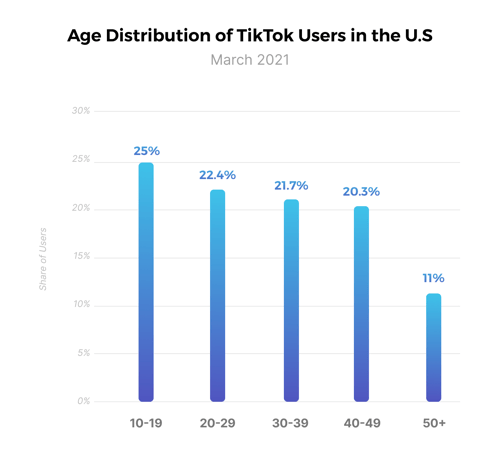TikTok has grown to such an extent that advertisers can simply no longer overlook it.
In September, the platform announced that it had crossed 1billion active monthly users, placing it 7th on the list of the most popular social networks globally. This milestone is even more impressive when you consider that TikTok was only launched internationally in late 2017, a fact that highlights the unmatched pace at which the app has spread from phone-to-phone.
I could continue to rattle off any number of statistics that speak to TikTok’s popularity, but there’s really no need. TikTok is big. It’s self-evident.
Coming from an advertising perspective, what I find even more impressive than TikTok’s rapid rise is just how transformational it has been—completely changing the game in terms of how people consume video content online.
The music-driven, fun, raw, and experimental short-form video content that make up TikTok feeds has formed a unique environment for brands to integrate into, both organically and through paid media—the latter being the focus of this article.
Before we discuss why TikTok deserves a prominent place in your media mix, let’s first tackle two of the common reasons I often see given by brands that feel apprehensive of adopting the platform.
#1 Won't TikTok only enable me to reach Gen Z audiences?
A lot has been made of the fact that TikTok users are considered to be generally younger than other social networks. For brands with young target demographics, this has resulted in TikTok being embraced as an effective method of connecting with Gen Z consumers.
But what if your target audience doesn’t fall into this demographic? Wouldn’t it be pointless to invest in TikTok ads?
Actually, no. This idea that “TikTok is only a Gen Z platform” is outdated. Whilst Gen Z were the earlier adopters, and still do represent the largest audience segment, the distribution of TikTok user ages has become increasingly diverse as the platform has grown.
The graph below highlights this, showing the breakdown of U.S TikTok user ages in March 2021.

Source: https://www.statista.com/statistics/1095186/tiktok-us-users-age/
As you can see, the 30–39, and 40–49 age brackets both make up a more than 20% share of TikTok’s user base, and if you combine these two with those aged 50+ you get 53% of TikTok users being between the ages of 30–50+.
So, with more TikTok users being over 30 than under, along with a diverse distribution of ages overall, you shouldn’t be put off by the idea that the platform is a Gen Z silo.
#2 Is TikTok a safe environment for my brand?
As the new kid on the advertising block, it is understandable that some brands were initially hesitant to advertise on TikTok, with some citing brand safety concerns. This hesitancy was mostly felt by larger, global companies for whom brand safety is extremely important.
However, ever since TikTok launched its advertising platform, “TikTok For Business”, the platform has been very active when it comes to brand safety measures, releasing a variety of different tools and solutions helping to provide peace-of-mind to advertisers.
For example, at this year’s TikTok World Event, the platform announced the launch of the TikTok Inventory Filter, a tool inspired by the GARM Brand Safety and Suitability framework that will enable advertisers to make informed decisions about the types of content their TikTok ads will appear next to. During the event, TikTok also announced new brand safety/suitability partnerships with Integral Ad Science and Zefr, along with the expansion of their partnership with Open Slate.
This shows that TikTok is making this a top priority, and is actively working to ensure that brands are confident that their ads will be placed in a safe, regulated space.
Why TikTok deserves to be a main player in your Media Mix
Hopefully I’ve helped to dispel these common concerns regarding TikTok advertising.
Without these hesitations holding you back, there is no reason not to make TikTok a main player in your paid social activity.
Earlier in this article I mentioned that TikTok offers brands a “unique environment” to advertise within. This environment exists due to the fact that TikTok—through its “Don’t Make Ads. Make TikToks” ethos—encourages and enables advertisers to deliver ads that don’t disrupt an user’s experience on the platform, and instead strive to be apart of the experience through authentic video.
This dynamic signals a change in how brands communicate with audiences through ads, or as Blake Chandlee, President of Global Business Solutions at TikTok puts it: “Brands have moved from talking to and at consumers, to effectively creating with them. At TikTok, we’ve been working non-stop to facilitate this.”
Consumers' expectations regarding ads have changed significantly in recent years. This was highlighted in IAB’s 2022 US Digital Advertising Outlook, where it was said that those in the industry need to be doing more to “meet consumers where they are, in the way they want, with advertising embedded in an authentic consumer-connection strategy.”
TikTok’s ad solutions have been developed specifically to help brands overcome this challenge of changing consumer expectations. For this reason, it's time to take TikTok seriously by making it a regular channel in your 2022 campaigns.











.png?width=159&height=159&name=Group%201000001080%20(1).png)

